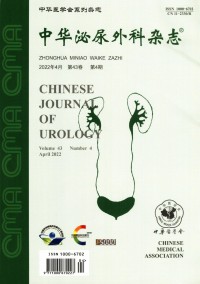Initial experience of modified transperitoneal laparoscopic pyeloplasty combined with a rigid ureteroscope with a deflectable tip( Sun’s ureteroscope) for the treatment of ureteropelvic junction obstruction with renal calculi
Q4 Medicine
引用次数: 0
Abstract
Objective To evaluate the efficacy and safety of Institution Urology of Peking University modified technique for transperitoneal laparoscopic pyeloplasty combined with deflectable tip rigid ureteroscope(the Sun's ureteroscope) in ureteropelvic junction obstruction(UPJO) complicated with renal calculi. Methods From January 2018 to September 2018, eight patients, including five males and three females, were diagnosed as UPJO with coexistent ipsilateral renal calculi in Peking University First Hospital and Changzheng Hospital of Second Military Medical University. The age ranged from 14 to 50 years(mean 28 years). Four patients had flank pain and one patient had flank pain with hematuria, while the other three patients came without clinical symptom.The BMI ranged from 16.8 to 26.2 kg/m2(mean 22.0 kg/m2). The lesion located on the left side in 4 cases and on the right side in 4 cases. One patient suffered with multiple pelvis stones. Four patients suffered with multiple lower calyceal stones, and 3 patients had solitary lower calyceal stone. The stone size ranged from 2 mm to 10 mm (mean 6.4 mm). 3 cases had slight hydronephrosis and 5 cases had moderate hydronephrosis. Two patients combined with crossing vessels. All patients underwent modified transperotoneal laparoscopic dismembered pyeloplasty with pyelolithotomy. In cases with left lesion, an incision was made for the veress needle 5mm inferior to the costal margin in the left midclavicular line to establish pneumoperitoneum . A 12-mm camera port was placed 30 mm inferior to the umbilicus and 10 mm lateral to the border of left rectus muscle. Then, a 5 mm operative trocars was inserted at 30mm superior to the umbilicus 10 mm lateral to the border of left rectus muscle. Another 12 mm operative trocar was inserted at the opposite McBurney point. The last 5 mm operative trocar was placed at the veress needle point. After visualizing the pelvis and the proximal ureter at the lower pole of the kidney, a 1.0 cm transverse incision on the lower pole of the pelvis above the obstruction site was made. The Sun’s ureteroscope was introduced into the renal pelvis through the 1.0 cm transverse incision via the 12-mm trocar below the umbilicus. Stones in the renal pelvis and calyces were extracted with basket catheters and removed via the port. After the pyelo-nephroscopy, a modified transperitoneal laparoscopic pyeloplasty was made. A F6 double-J stent was inserted into the ureter during the surgery. Result All surgeries were finished successfully without conversion. The surgical duration ranged from 111 to 185 min(mean 135 min). The estimated blood ranged from 10 to 50 ml(mean 38.8 ml). The hospital stay ranged from 3 to 7 days(mean 4 days). The intraoperative stone free rate was 100%(8/8). No perioperative complications occured. With the follow-up from 6 to 14.4 months(mean 8.9 months), there was no evidence of obstruction in all patients, as confirmed by symptoms or radiological improvement of hydronephrosis, and two patients found recurrence of renal calculi. Conclusions Our modified technique for transperitoneal laparoscopic pyeloplasty combined with deflectable tip rigid ureteroscope(the Sun′s ureteroscope) is a safe, effective method to manage ureteropelvic junction obstruction with renal calculi. Key words: Ureteroscope; Laparoscopic pyeloplasty; Ureteropelvic junction obstruction; Renal calculus改良经腹膜腹腔镜肾盂成形术联合尖端可偏转的刚性输尿管镜(孙氏输尿管镜)治疗肾盂输尿管连接处梗阻合并肾结石的初步经验
目的评价北京大学泌尿外科改良技术经腹腔腹腔镜肾盂成形术联合可偏转尖端硬质输尿管镜(孙氏输尿管镜)治疗肾盂输尿管连接处梗阻(UPJO)并发肾结石的疗效和安全性。方法2018年1月至2018年9月,在北京大学第一医院和第二军医大学长征医院诊断为UPJO合并同侧肾结石的患者8例,男5例,女3例。年龄14 ~ 50岁,平均28岁。4例患者有侧腹疼痛,1例患者有侧腹疼痛并血尿,其余3例患者无临床症状。BMI范围为16.8 ~ 26.2 kg/m2(平均22.0 kg/m2)。病变位于左侧4例,右侧4例。一名患者患有多发骨盆结石。4例为多发下盏结石,3例为单发下盏结石。石头的大小从2毫米到10毫米不等(平均6.4毫米)。轻度肾积水3例,中度肾积水5例。2例合并交叉血管。所有患者均行改良经肾盂腹腔镜碎裂肾盂成形术合并肾盂取石术。左侧病变时,在左锁骨中线肋缘下5mm处用横针切开,建立气腹。在脐下30毫米,左直肌边界外侧10毫米处放置一个12毫米的摄像口。然后,在脐上30mm左直肌边界外侧10mm处插入一个5mm的手术套管。另一个12毫米的手术套管针在对面的McBurney点插入。最后一个5mm的手术套管针放置在侧针点。在肾脏下极骨盆和输尿管近端可见后,在梗阻部位上方骨盆下极做一个1.0 cm的横向切口。Sun输尿管镜经脐下12mm套管针经1.0 cm横切口进入肾盂。肾盂和肾盏内的结石用筐式导尿管取出,经肾口取出。在肾盂肾镜检查后,进行改良的经腹膜腹腔镜肾盂成形术。术中输尿管内置入F6双j型支架。结果所有手术均顺利完成,无转阴。手术时间为111 ~ 185分钟(平均135分钟)。估计血从10到50毫升(平均38.8毫升)。住院时间3 ~ 7天(平均4天)。术中结石清除率100%(8/8)。无围手术期并发症发生。随访6 ~ 14.4个月(平均8.9个月),所有患者均无梗阻迹象,经肾积水症状或影像学改善证实,2例患者发现肾结石复发。结论经腹腔镜肾盂成形术联合可偏转尖端硬质输尿管镜(孙氏输尿管镜)是治疗肾盂输尿管交界梗阻合并肾结石安全、有效的方法。关键词:输尿管镜;腹腔镜肾盂成形术;输尿管盂连接处梗阻;肾结石
本文章由计算机程序翻译,如有差异,请以英文原文为准。
求助全文
约1分钟内获得全文
求助全文
来源期刊

中华泌尿外科杂志
Medicine-Nephrology
CiteScore
0.10
自引率
0.00%
发文量
14180
期刊介绍:
Chinese Journal of Urology (monthly) was founded in 1980. It is a publicly issued academic journal supervised by the China Association for Science and Technology and sponsored by the Chinese Medical Association. It mainly publishes original research papers, reviews and comments in this field. This journal mainly reports on the latest scientific research results and clinical diagnosis and treatment experience in the professional field of urology at home and abroad, as well as basic theoretical research results closely related to clinical practice.
The journal has columns such as treatises, abstracts of treatises, experimental studies, case reports, experience exchanges, reviews, reviews, lectures, etc.
Chinese Journal of Urology has been included in well-known databases such as Peking University Journal (Chinese Journal of Humanities and Social Sciences), CSCD Chinese Science Citation Database Source Journal (including extended version), and also included in American Chemical Abstracts (CA). The journal has been rated as a quality journal by the Association for Science and Technology and as an excellent journal by the Chinese Medical Association.
 求助内容:
求助内容: 应助结果提醒方式:
应助结果提醒方式:


